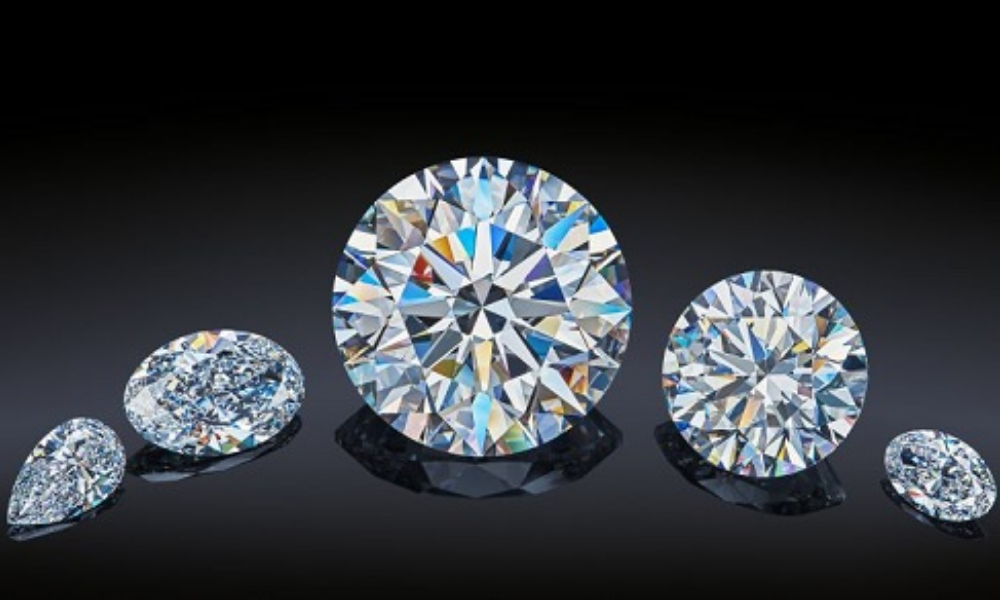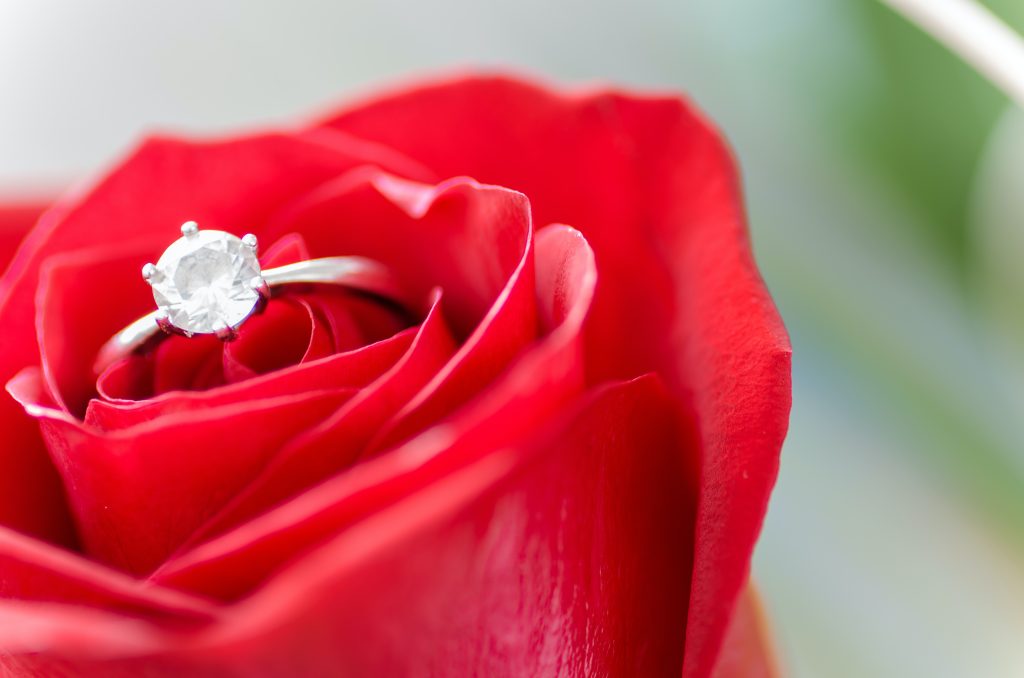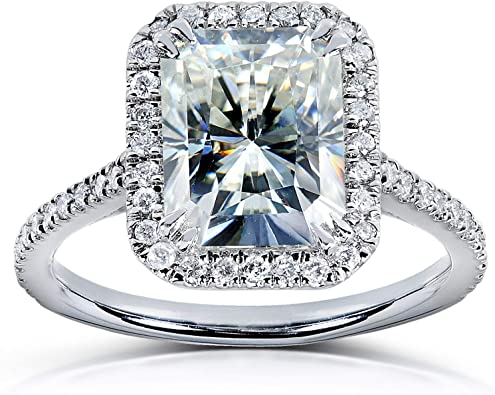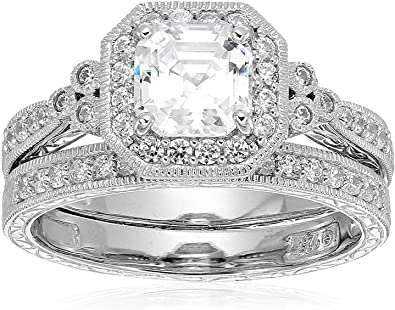When deciding between a moissanite band and a cubic zirconia ring, the gemstone quality should be considered. Moissanite is a more durable gemstone than cubic zirconia, making it a superior choice for engagement rings. Because of its high refractive index, the light will be reflected more brilliantly from its surface due to its composition. Another element that makes Moissanite a superior choice for engagement rings is the low cost of the gemstone. It’s also an excellent alternative to a clear gemstone because it’s less prone to be scratched than a clear gemstone.
When selecting an engagement ring, the cost is usually one of the most important considerations when deciding on a style, metal, and gemstone. Should you choose traditional diamonds or an artificial stone such as Moissanite or cubic zirconium for your engagement ring? First and foremost, it’s critical to comprehend the differences between the two. Even though many people assume the differences between Moissanite, cubic zirconium, and diamonds are insignificant, each stone has an entirely distinct impression.
Moissanite Vs. Diamond Vs. Cubic Zirconia
What is Moissanite?
In contrast to most other gemstones, Moissanite is genuinely out of this world — literally. Henri Moissan was discovered in 1893 when he discovered minute particles of what is now known as Moissanite in a crater caused by a meteorite hit in Arizona. Moissan was the first person to find Moissanite. Moissan initially believed he had discovered diamonds, but upon closer inspection, he realized that the particles were composed of silicon carbide rather than carbon.
Moissanite is extremely rare in nature, and as a result, most moissanite stones are currently created in laboratories. Even though Moissanite is designed to look like diamonds, there are significant differences between the two.
Moissanite Vs Diamond
Moissanite has a lower hardness rating on the Mohs Scale of Hardness when compared to diamonds. The diamond scores a perfect ten even though it has a hardness of 9.25 (making it an extremely durable stone). The difference of.75 is not significant enough to overshadow the Moissanite’s exceptional durability. Neither stone is too delicate to be worn as an engagement ring daily. However, a diamond remains the gold standard when it comes to hardness.
When it comes to brilliance, Moissanite has a different effect than a diamond because of its composition. Moissanite’s unique faceted design gives a rainbow-like effect when the stone is worn. However, while some consumers like the pop of color, others believe the stone resembles a disco ball more closely than a diamond. The magnitude of this effect is only increased when the size of the stone grows. On the other hand, Diamonds are only concerned with displaying their famed shine.
Even though colorless diamonds have a white look, the so-called “colorless” Moissanite can nonetheless have a yellowish or greyish tint to their appearance. It makes up for the shortcomings of Moissanite in terms of hardness, brilliance, and color by offering more affordable pricing. Moissanite engagement rings are substantially less expensive compared to diamond engagement rings. Lab-created diamonds are less expensive than naturally occurring diamonds, even though they are still more expensive than Moissanite.
Cubic Zirconia Origins
Cubic zirconia engagement rings are another popular alternative to diamond engagement rings. This stone is entirely created in a laboratory, but it is intended to have the same shine as a natural diamond in appearance. The cubic crystal symmetry of zirconium oxide and the chemical makeup of zirconium oxide give it its name.
Cubic zirconia is highly prized since it is low maintenance while evoking images of diamonds in the customer’s mind. In contrast to Moissanite, Cubic zirconia can be produced entirely colorless, putting it on par with diamonds in terms of color.
German mineralogists were the first to identify naturally occurring cubic zirconia. Still, it wasn’t until the 1960s that single-crystal cubic zirconia began to be manufactured, and it was the Soviets eventually mastered the manufacturing process. Even though lab-grown diamonds and cubic zirconia are both generated artificially, there is a significant distinction between the two. In contrast to cubic zirconia, which is created to have the appearance of diamonds, lab-grown diamonds are constituted entirely of carbon atoms (as opposed to mined or natural diamonds).
Diamond Vs. Cubic Zirconia
Cubic zirconia is substantially less expensive than diamonds when compared side by side. Consequently, cubic zirconia may be an affordable option for any customer looking for a specific setting, design, or engagement ring. Additionally, the wait times are often substantially less when ordering cubic zirconia instead of diamonds.
Even though cubic zirconia is still durable, its hardness does not become comparable to that of a diamond; cubic zirconia has an 8.5 on the Mohs Scale of Hardness. On the other hand, CZ is naturally faultless since it has been artificially manufactured in a laboratory. On the other hand, Diamonds are only very rarely (if ever) perfect in appearance.
If you’re looking for a stone that sparkles, a diamond is your best bet. As a result of having a far lower refractive index than a diamond, cubic zirconia collects light differently and glows less than a diamond.
Every gemstone has its advantages and disadvantages, but a diamond is nearly usually the favored gem used in an engagement ring. A diamond (whether mined or created in a laboratory) is rated a perfect ten on the Mohs Scale of Hardness, making it highly durable and suited for everyday wear. Furthermore, the color is pure and does not contain any hues of yellow or grey, and no other diamond alternative comes close in terms of glitter and brightness.
Of course, the price of a diamond is usually more than its value, but the value of a diamond is also higher. This will result in a far more durable and brilliant stone for the wearer, who will be delighted to show off his or her diamond engagement ring with relatives and friends.
Moissanite Vs. Cubic Zirconia
Moissanite is a more durable gemstone than Cubic Zirconia. When comparing the hardness of the two gemstones, CZ has less than one-half (45 percent) the hardness of Moissanite, according to the Knoop indentation test (which measures hardness). The test results show that CZ 1370 outperforms Moissanite 3000, which indicates that Moissanite is 219 percent harder than diamond.
When comparing toughness, which is the resistance to chipping and breaking, Moissanite comes out on top, with its chipping resistance being nearly 300 percent more than that of a diamond. The PSI of a CZ is 2.4, whereas the PSI of Moissanite is 7.6. Because of Moissanites’ extremely high hardness and durability, they will not scratch, chip, or wear like a CZ stone would.
In addition to having a high refractive index of 2.69, Moissanite also has a refractive index that is 25 percent more than that of a diamond. The higher the refractive index of a gemstone, the more brilliance it emanates when illuminated. The dispersion of light in Moissanite is 58 percent larger than that of cubic zirconia. As a result, Moissanite emits more fire and bursts of rainbow light than cubic zirconia. Moissanite has a shine that is 50 percent higher than that of cubic zirconia. The higher the luster of a gemstone, the more significant the amount of light reflected off the gemstone’s facetted surface.
Moissanite has a higher heat tolerance than CZ, a gemstone that is extremely sensitive to heat. Particular jewelers may reject your request for alterations to your CZ jewelry, such as sizing or repairs if you want to acquire a cubic zirconia stone.
In conclusion, this month’s topics included diamonds, cubic zirconia, and Moissanite jewelry. Swede’s Jewelers is committed to ensuring that our consumers are well-informed and educated. Please stop by our store and see what best suits your style and preferences, and we are available at all times to assist you.
Kobelli Radiant-cut Moissanite Engagement Ring 3 CTW 14k White Gold
Features
- Large Halo Moissanite and Diamond Engagement Ring by Kobelli
- Kobelli Moissanite center stone measures 9x7mm
- Over 50 Natural Earth-mined white diamonds (conflict-free)
- Radiant cut moissanite, round-brilliant cut diamonds
- Proposal-ready ring box included
Amazon Collection Classic Twist with White Diamond Sterling Silver Ring (1/10cttw, I-J Color, I2-I3 Clarity)
Features
- Twisted sterling silver ring encased with sparkling white diamonds
- All our diamond suppliers confirm that they comply with the Kimberley Process to ensure that their diamonds are conflict-free
- Imported
- An Amazon Brand
Amazon Collection Platinum or Gold Plated Sterling Silver Infinite Elements Zirconia Antique Ring Set
Features
- Sparkling antique-style ring with Asscher-cut Infinite Elements Cubic Zirconia and band with prong-set faceted rounds.
- Both bands are adorned with prong-set faceted round brilliant cut Infinite Elements Cubic Zirconia.
- This jewelry design was manufactured with the highest quality standards. All efforts are being made to use sustainable resources and socially responsible providers.
- This item runs somewhat large, those between sizes should round down.
- These silver pieces are built for longevity. This piece features a metal plating or flashing, or an electrocoating for a more lustrous appearance, but it can wear off with long-term or heavy use. To ensure the longevity of your plated items store your jewelry in a dark, cool, dry place such as a pouch or air-tight box, and avoid rubbing plated items together. Also, try to avoid exposure to cleaning products and perfume which can both negatively affect your items. Your local jeweler can advise you where to send your jewelry if you would ever like them replated.
Which is Superior, Moissanite, or Cubic Zirconia?
Moissanite has a toughness rating of 7.6 PSI, whereas CZ has a toughness value of only 2.4 PSI. In other words, Moissanite is more than three times more resistant to shattering or chipping than cubic zirconia. Moissanite was declared the winner, and it is 1.25 points harder than CZ and three times more difficult than CZ.
Moissanite has a hardness rating of 9.25, while CZ has 8-8.5. This implies that Moissanite is significantly more challenging than other gemstones. When it comes to the “toughness” grade, which indicates how probable or unlikely the stones will break, Moissanite stands head and shoulders above the competition.
Is Moissanite or Diamond a Better Choice?
“On the Mohs hardness scale, moissanite is second only to diamonds in terms of hardness,” O’Connell explains. “On a scale from one to ten, diamonds receive a ten, whereas moissanite receives a 9.25-9.5.” Moissanite is a reasonably durable choice for an engagement ring stone, mainly because the substance is not easily scratched like other gemstone options.
The price of Moissanite is perhaps the most significant advantage it has over diamonds, as Moissanite is far less expensive than a diamond. A moissanite gem, according to O’Connell, costs around one-tenth the price of a mined diamond of the same size and grade. “The value of moissanite increases as the carat weight of the stone increases.”
Is Moissanite a Good Investment?
Moissanites are not precious, even though they are inexpensive. However, while we don’t recommend diamonds as an investment (since you’ll nearly always lose money if you decide to sell), they can hold their value over time. They can be passed down from generation to generation as precious family heirlooms, which is impossible with Moissanite.
Is Moissanite a Cloudy Stone?
Because it is one of the most complex substances on the planet, it is an excellent choice for an engagement ring stone. Moissanite stones are highly scratch-resistant and brilliant, and they will never tarnish or become clouded, as we can guarantee a lifetime warranty!
Moissanite is derived from a naturally occurring mineral known as silicon carbide. As a result, Moissanite will never grow hazy, discolored, or otherwise alter its appearance. A Moissanite will retain its brilliance, color, and clarity for the rest of its natural life.
Conclusion
Even though cubic zirconia (CZ) is a more economical option, Moissanite is the prominent diamond simulant due to its durability, brilliance, and overall worth, making it the superior pick. Nothing can compare to a diamond in terms of prestige and class, yet Moissanite comes close in terms of appearance. It is unfortunate because CZ will always be perceived as inexpensive and of little value.
When comparing the cost of moissanite with diamonds, moissanite is a more affordable option. Couples are increasingly choosing a moissanite ring over a diamond ring as their engagement jewelry. Moissanite rings are a wonderful alternative to diamond rings because there are no ethical concerns associated. Diamonds, on the other hand, are still more expensive than the less expensive options, so it may be worthwhile to choose one over the other.












